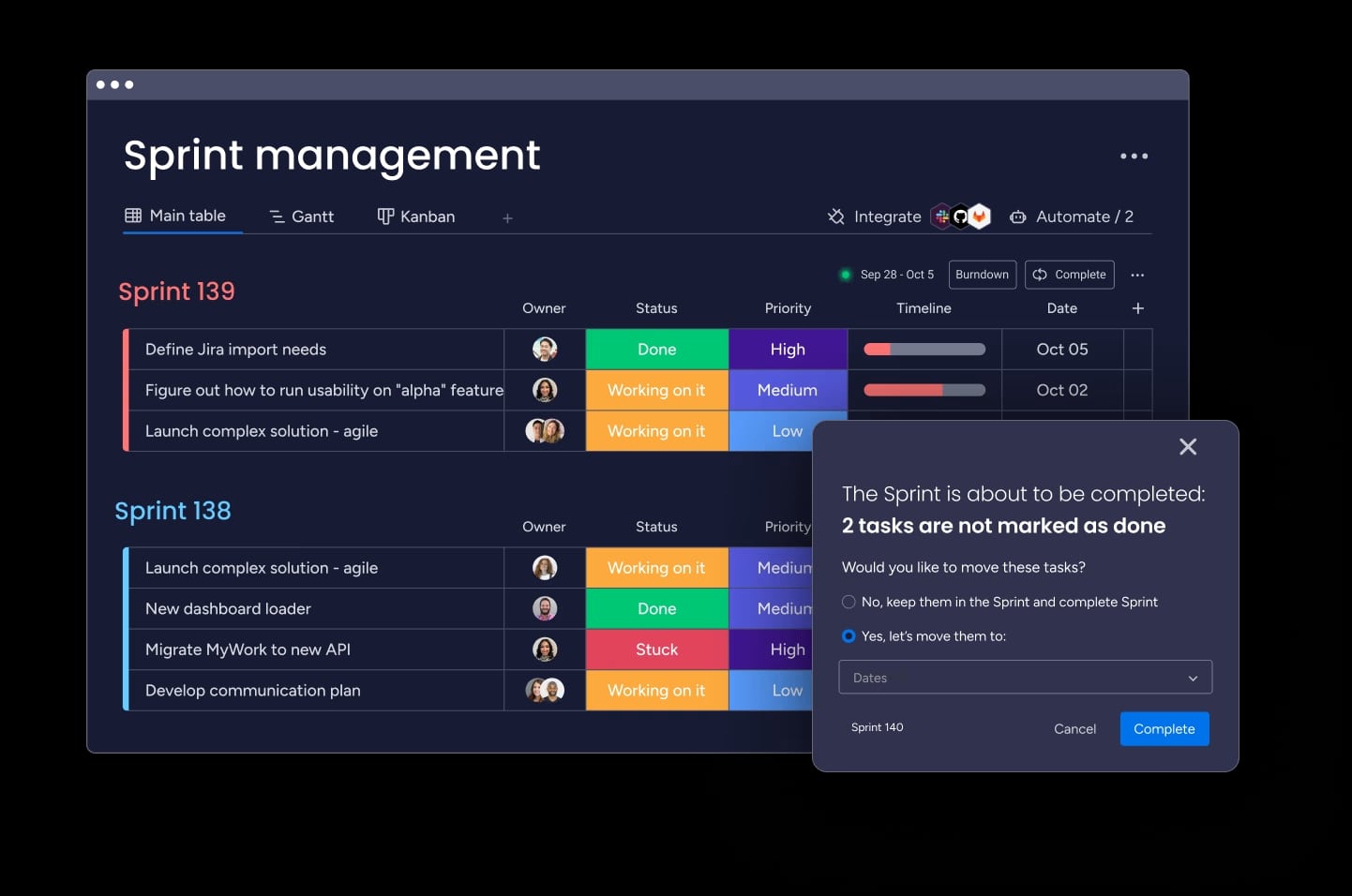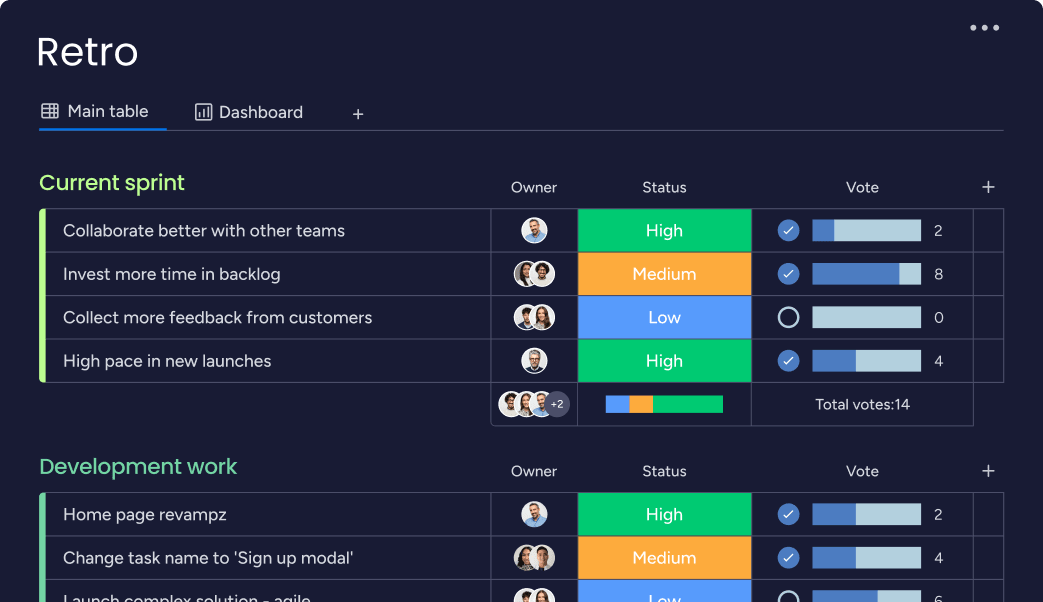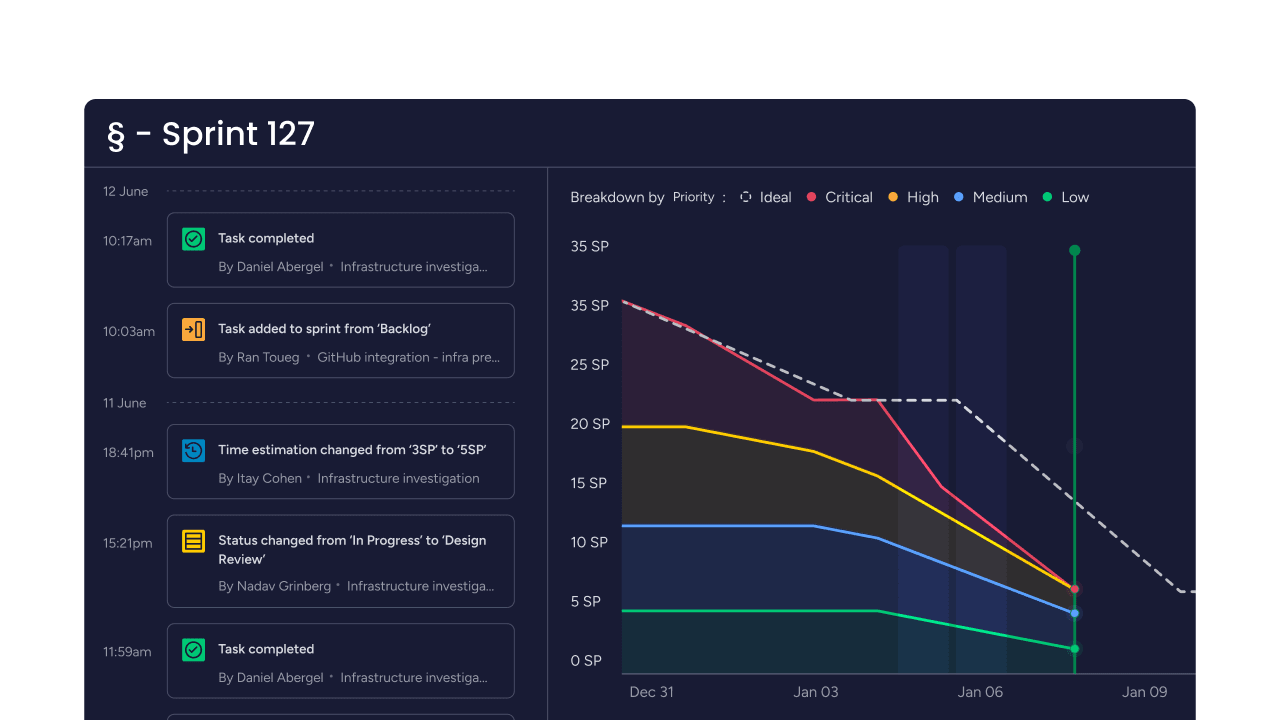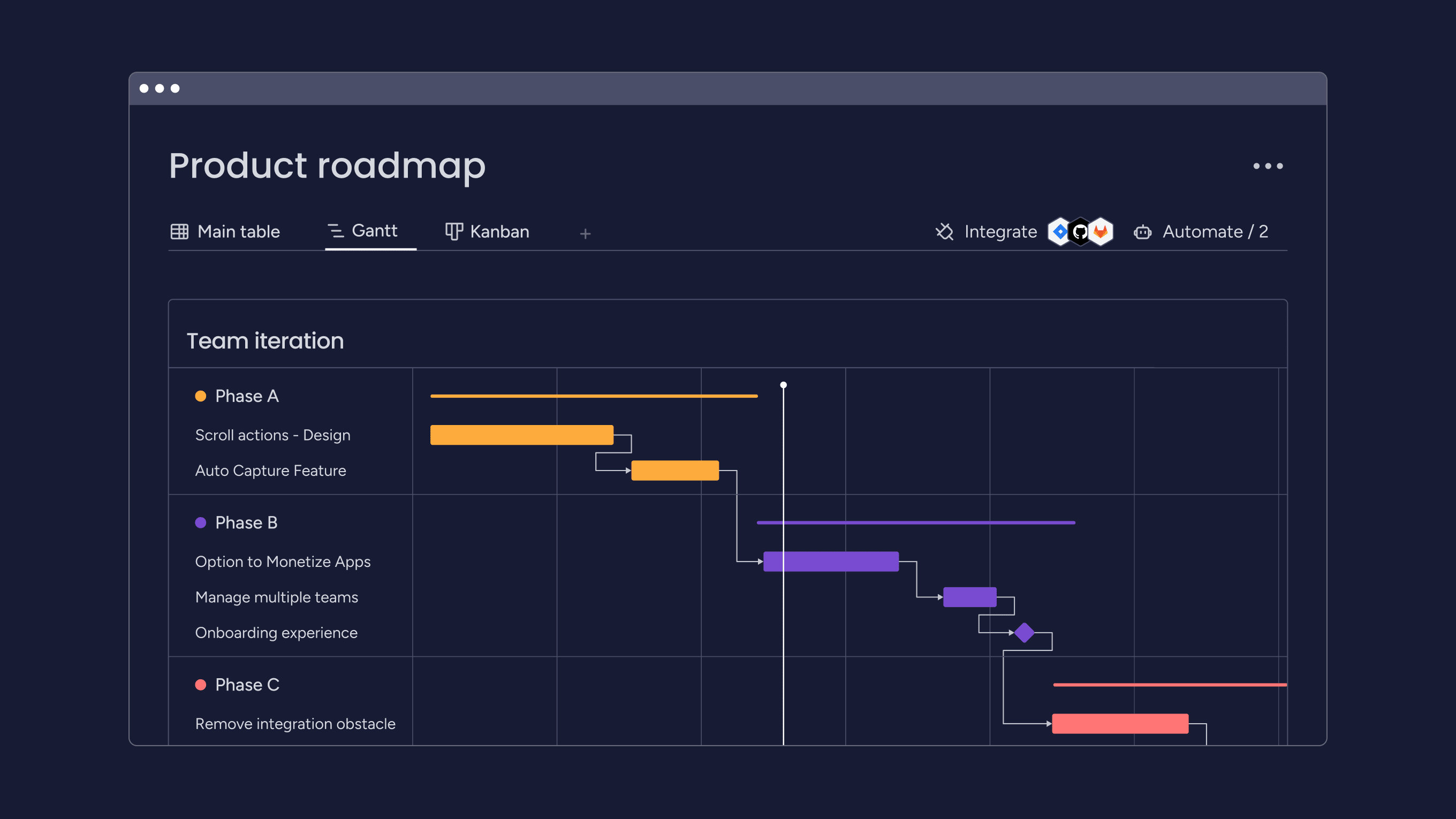Agile teams move fast — until growth slows them down. What once worked perfectly for one small team can start to unravel when dozens of teams try to move in sync. Dependencies multiply, priorities collide, and visibility fades. Suddenly, the same agile practices that fueled innovation now create friction.
That’s when organizations face a pivotal choice: stay nimble with Scrum or scale systematically with SAFe. Both frameworks promise agility, but they operate at entirely different levels. Knowing which one fits your team’s size, structure, and goals can make the difference between smooth collaboration and constant chaos.
In this article, we’ll unpack how SAFe and Scrum differ across seven key dimensions — from team structure and planning cadence to flexibility and implementation complexity — and explore when to use each (or both) to keep your organization delivering at its best.
Key takeaways
- Scale determines choice: use Scrum for single, autonomous teams (5–9 people) who prioritize speed. Choose SAFe when coordinating large programs (50+ people) across multiple interdependent teams.
- Complexity varies dramatically: Scrum can be implemented quickly (days/weeks), while SAFe requires significant investment, extensive training, and months of organizational change to implement properly.
- Planning cycles match delivery: Scrum’s short one to four week sprints enable rapid pivots. SAFe’s longer 8–12 week Program Increment (PI) cycles provide stability for complex, integrated solutions.
- Hybrid approach is common: many organizations successfully combine both approaches, using Scrum for daily team execution within SAFe’s broader coordination and alignment structure.
- Platform adaptability: Flexible platforms like monday dev adapt to both frameworks seamlessly, offering flexible workflows for Scrum sprints or complex SAFe program boards, plus AI-powered insights that scale from team metrics to portfolio visibility.

What is Scrum?
Scrum is a lightweight Agile framework that helps small teams deliver working software through short, focused work cycles known as Scrum sprints, and it’s the most popular agile methodology, with a 2022 report from Electro-IQ showing 87% Scrum usage among agile practitioners. Teams of five to nine people work together for one to four weeks at a time, building and releasing features incrementally.
The framework gives you just enough structure to stay organized while keeping the flexibility to adapt quickly. You’ll find the three pillars of Scrum guide every Scrum practice:
- Transparency: everyone sees the same information about work progress and obstacles.
- Inspection: regular checkpoints to review what’s working and what isn’t.
- Adaptation: quick adjustments based on what you learn during each sprint.
Core Scrum roles explained
Every Scrum team has three essential roles that work together to deliver value. These roles create clear accountability without adding unnecessary hierarchy. They also help reinforce essential Scrum values that guide how the team collaborates and delivers results.
- Product Owner: decides what features to build and in what order.
- Scrum Master: helps the team follow Scrum practices and removes blockers.
- Development Team: builds, tests, and delivers the actual product.
Sprint-based delivery
Sprints give your team a predictable rhythm for planning, building, and delivering work. Each sprint includes four key Scrum meetings that keep everyone aligned:
- Sprint planning: kicks off each cycle. Your team selects work from the backlog and creates a realistic plan for the sprint.
- Daily standups: take just 15 minutes. Team members share progress, plans for the day, and any blockers they’re facing.
- Sprint review: happens at the end. You demonstrate completed work to stakeholders and gather feedback.
- Sprint retrospective: closes the loop. The team reflects on what went well and what to improve next time.
Team-level agility
Scrum empowers small teams to make decisions quickly without waiting for approval from multiple layers of management. If you’re weighing Agile vs Scrum, remember Scrum gives you tighter feedback loops in smaller team environments.
Teams self-organize around the work, choosing how to accomplish sprint goals. Platforms like monday dev support this flexibility with customizable boards, including a Scrum board option, that adapt to your team’s specific workflow and preferences.
What is SAFe (Scaled Agile Framework)?
SAFe is a comprehensive Scaled Agile Framework that scales agile practices across large enterprises, and its popularity is clear, with over 70% of Fortune 100 companies using it to manage multiple teams and complex dependencies. Where Scrum focuses on single teams, SAFe coordinates 50-125+ people working together on integrated solutions.
The framework combines proven agile methods — including Scrum, Kanban, and Lean — into a structured system for enterprise delivery. SAFe addresses challenges that emerge when you need dozens of teams to work in sync toward shared business goals.
Enterprise-wide structure
SAFe organizes work across four distinct levels, creating alignment from strategy to execution:
- Team level: individual agile teams use Scrum or Kanban for daily work.
- Program level: Agile Release Trains (ARTs) coordinate 5-12 teams on related features.
- Portfolio level: leaders set strategic themes and fund initiatives.
- Large solution level: multiple ARTs collaborate on complex systems.
This structure ensures everyone understands how their work connects to larger business objectives. Each level has specific roles and responsibilities that maintain alignment without creating bottlenecks.
Program Increment (PI) planning
PI planning is SAFe’s signature event where entire programs align on what they’ll deliver over the next 8-12 weeks. Unlike sprint planning for single teams, PI planning brings together all teams, stakeholders, and leaders in one room (physical or virtual).
During these two-day sessions, teams identify dependencies, negotiate scope, and commit to shared objectives. Everyone leaves with a clear understanding of what each team will deliver and how their work fits together.
The longer planning horizon provides stability for complex initiatives while still allowing teams to iterate within each PI.
Multiple team coordination
Coordinating many teams requires specialized roles that don’t exist in standard Scrum. These roles create a necessary layer of oversight and facilitation, ensuring that dozens of teams can work in sync without getting bogged down by cross-team issues.
- Release train engineer: facilitates the entire ART and removes cross-team impediments.
- System architect: ensures technical decisions align across all teams.
- Product manager: defines features at the program level, working with multiple Product Owners.
These roles create a coordination layer that keeps teams aligned without micromanaging their daily work. They focus on removing obstacles and ensuring smooth handoffs between teams, much like a Scrum Master does on a single-team level.

SAFe vs Scrum: at a glance
Each framework takes a distinct approach to scaling agile practices. This quick comparison outlines the major contrasts between Scrum and SAFe so you can identify which better fits your organization’s size and complexity.
7 key differences between SAFe and Scrum
1. Scale and team size
Scrum works with single teams of five to nine people who can communicate directly and make decisions together. This small size enables quick pivots and minimal coordination overhead.
SAFe coordinates multiple teams — typically 50-125 people in an Agile Release Train. At this scale, you need formal coordination mechanisms to keep everyone moving in the same direction.
When comparing SAFe vs Scrum, the difference affects everything from meeting structures to decision-making speed. What takes a quick conversation in Scrum might require scheduled coordination in SAFe.
2. Organizational structure
Scrum keeps things simple, relying on three core roles and a flat structure. Teams self-organize around shared goals, make quick decisions, and stay close to the work that delivers value.
SAFe, on the other hand, scales this simplicity into an enterprise framework. It introduces structured layers and specialized roles — like Release Train Engineers, System Architects, and Product Managers — to coordinate dozens of interconnected teams working toward the same objectives.
Whether your organization favors Scrum’s lean hierarchy or SAFe’s multi-level alignment, solutions like monday dev adapt easily. The platform supports flexible role management and permissions, so teams can stay autonomous while leadership maintains the visibility and control needed for large-scale coordination.
3. Planning cycles
Scrum’s short sprints let you adjust course every few weeks based on feedback and changing priorities. You can pivot quickly when market conditions shift or new opportunities emerge.
SAFe’s Program Increments provide a stable planning horizon for complex initiatives. The 8-12 week cycles give teams enough time to build significant features while coordinating dependencies.
These different rhythms serve different needs. Short cycles work well for rapid experimentation, while longer cycles support complex integration work.
4. Roles and responsibilities
In Scrum, the Product Owner, Scrum Master, and Development Team handle everything needed to deliver value. These roles stay consistent regardless of what you’re building.
SAFe expands these roles and adds new ones to handle enterprise complexity:
- Scrum Masters: coordinate with other teams, not just their own.
- Product Owners: align with Product Managers on program priorities.
- New roles: like Release Train Engineer keep the whole system running smoothly.
5. Flexibility vs structure
Scrum gives teams freedom to adapt their processes based on what works. You can experiment with different practices and keep what helps you deliver value faster.
SAFe provides more prescribed processes to ensure consistency across teams. While this reduces flexibility, it helps large organizations coordinate effectively and maintain quality standards.
The trade-off depends on your context. Small teams benefit from maximum flexibility, while large programs need some standardization to function.
6. Dependency management
Scrum teams minimize dependencies by staying small and cross-functional. When dependencies exist, you handle them through direct communication.
SAFe explicitly manages dependencies through structured planning and coordination. PI planning surfaces dependencies early, and ongoing sync meetings keep teams aligned as work progresses.
This reflects the reality that large systems have unavoidable dependencies. SAFe provides mechanisms to identify and manage them proactively rather than letting them become surprises.
7. Implementation complexity
You can start using Scrum tomorrow with minimal training. Teams learn by doing and improve through regular retrospectives.
SAFe requires significant investment in training, coaching, and organizational change. Most organizations take months or years to fully implement SAFe across all teams.
The payoff matches the investment: Scrum delivers quick wins for small teams, while SAFe enables coordination at scale that would be impossible otherwise.

When to use Scrum vs SAFe
Scrum and SAFe aren’t competing philosophies — they’re designed for different scales of work. Understanding when to use each ensures your teams stay fast, focused, and aligned.
Choose Scrum
Scrum shines in environments where teams can work independently and adapt quickly. Consider Scrum when you have:
- Small, autonomous teams: building distinct products or features.
- Startup environments: where speed and experimentation matter most.
- Simple architectures: with minimal technical dependencies.
- Agile-friendly culture: that embraces self-organization and shared ownership.
These conditions let you maximize Scrum’s strengths including rapid delivery, quick feedback loops, and minimal overhead. Your teams can focus on building great products rather than managing complex processes.
Choose SAFe
SAFe addresses coordination challenges that emerge at enterprise scale. Look to SAFe when you face:
- Multiple interdependent teams: building integrated systems.
- Regulatory requirements: demanding extensive documentation and compliance.
- Complex portfolios: where products share platforms or components.
- Traditional organizations: transitioning from waterfall methods.
SAFe provides the structure these situations require while preserving agility at the team level. The framework helps you manage complexity without sacrificing delivery speed.
When to use SAFe and Scrum together
Many organizations successfully combine both frameworks — using Scrum for team-level execution within SAFe’s coordination structure. This hybrid approach captures the benefits of both worlds.
Teams continue their Scrum ceremonies and practices while participating in PI planning and program-level coordination: they maintain autonomy for daily decisions while aligning with broader objectives.
This combination works particularly well when you need both local agility and enterprise coordination. Teams can respond quickly to immediate needs while contributing to strategic initiatives.

Completely transform your Agile implementation with monday dev
Sophisticated solutions like monday dev adapt to your chosen framework without forcing rigid structures. Whether you’re running Scrum sprints or coordinating SAFe programs, the intelligent platform provides powerful Agile project management features to give teams the flexibility and visibility they need.
Flexible workflows that adapt to you
Create workflows that match your exact needs: from simple Scrum boards to complex SAFe program boards. Pre-built templates help you start quickly, while customization options let you refine processes over time.
Use the Sprint Board view to visualize your current sprint with drag-and-drop simplicity, or switch to the Roadmap view to map out multiple Program Increments across your entire release train. The Kanban view helps teams manage work-in-progress limits, while the Gantt chart reveals dependencies between teams and features.
Teams can design their ideal sprint workflow with custom statuses, priority fields, and story point tracking, while program managers use the Portfolio Board to track cross-team dependencies and feature progress. Everyone works in views optimized for their role without losing sight of the bigger picture.
Complete visibility without the overhead
Real-time dashboards automatically aggregate performance data across teams and projects, ensuring that both teams and leadership have the visibility they need. This eliminates manual reporting and provides immediate, actionable insights.
- Team performance metrics: sprint metrics like velocity, burndown charts, and cycle time help teams continuously improve. The Sprint Widget displays current progress at a glance, showing completed versus planned story points.
- Instant health indicators: features like “Battery Columns” provide instant visual indicators of sprint health, turning red when teams are at risk of missing commitments. Time tracking integration captures actual effort without disrupting flow.
- AI-driven insights: AI-driven analytics identify patterns and predict potential issues before they impact delivery. For teams seeking more advanced Scrum tools, platforms like monday dev can streamline backlog management with automated prioritization and automate repetitive tasks like status updates and stakeholder notifications.
- Portfolio views: High-level portfolio views give leaders the strategic insights needed for critical business and investment decisions.
Scale confidently with AI-powered insights
AI capabilities enhance both frameworks by automating routine work and surfacing important insights. The AI assistant can categorize incoming work items by epic or feature area, suggest task assignments based on team members’ skills and current workload, and identify risks based on historical patterns and velocity trends.
For Scrum teams, AI helps with sprint planning by recommending optimal story point allocations and flagging capacity concerns before you commit. The AI-powered retrospective summary analyzes team feedback to highlight recurring themes and suggest concrete improvements.
For SAFe implementations, AI identifies cross-team dependencies by analyzing linked items across boards and suggests coordination strategies when it detects potential conflicts. The dependency map automatically visualizes relationships between features, helping Release Train Engineers spot bottlenecks during PI planning.
These intelligent features reduce manual overhead while helping teams continuously improve their delivery effectiveness. Automated workflows trigger notifications when blockers arise, update stakeholders on milestone progress, and sync data between team boards and program-level tracking — all without manual intervention.
Frequently asked questions
What is the main difference between SAFe and Scrum?
The main difference between SAFe and Scrum is scale — Scrum works for single teams of five to nine people, while SAFe coordinates 50-125+ people across multiple teams to deliver enterprise solutions.
Is SAFe more complex than Scrum?
Yes, SAFe is significantly more complex than Scrum, requiring extensive training and organizational change while Scrum can be implemented quickly with minimal overhead.
Do I need different platforms for SAFe vs Scrum?
Not necessarily. Both frameworks can run effectively on the same agile platform — what matters is scalability. Scrum teams need lightweight boards for sprint planning and daily tracking, while SAFe adds layers for program management, dependencies, and portfolio oversight.
Can small teams use SAFe effectively?
Not really. SAFe is built for large organizations with multiple interdependent teams. For a small team, the added structure and coordination layers would create more overhead than benefit.
Which framework delivers faster results?
Scrum typically delivers faster initial results due to its simplicity, while SAFe takes longer to implement but provides more predictable outcomes at enterprise scale.
How do certifications differ between SAFe and Scrum?
Scrum offers simpler certifications for its three core roles, while SAFe provides extensive role-specific certifications reflecting its enterprise focus and complexity.
 Get started
Get started 


